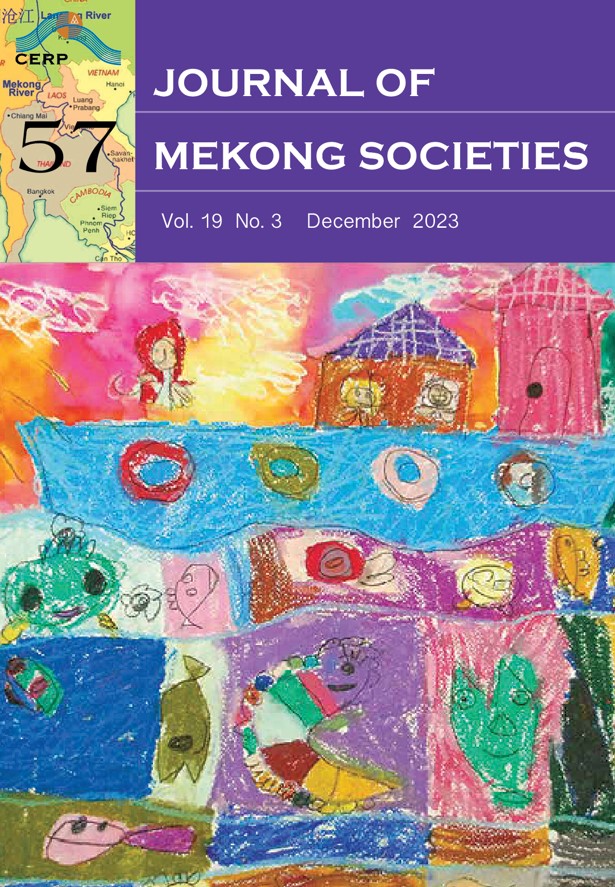The Dynamics of Dai Lue Vernacular Houses: A Comparative Study of House Forms and Spatial Organization in Xishuangbanna, Yunnan, China and Mainland Southeast Asia
Main Article Content
Abstract
Although the traditional homeland of the Dai Lue ethnic group is located in Xishuangbanna, Yunnan province, Southwest China, the Dai Lue people have migrated to places in Mainland Southeast Asia, including Myanmar, Laos, Vietnam, and Thailand. Currently, Xishuangbanna society is undergoing major changes in lifestyle and culture, some of which are reflected in Dai Lue houses. This article focuses on Dai Lue house forms and spatial organization to understand the people’s lifestyle and culture through vernacular houses in different contexts. The study argues that both environmental and socio-cultural factors determine the houses’ building materials, construction, and settings. The findings show that the characteristics of Dai Lue houses in Xishuangbanna differ from those of traditional houses, while those in dispersed settlements better retain the traditional form and are changing more slowly.
Article Details

This work is licensed under a Creative Commons Attribution-NonCommercial-NoDerivatives 4.0 International License.
References
Bosab, T. (2009). Phattanakan rupbaep ban ruean Tai Lue Mueang La, Rat Shan. (In Thai) [Development of Tai Lue house patterns in Mong La, Shan State]. Master of Architecture in Vernacular Architecture thesis, Silpakorn University.
Gao, Y. (1995). Symbolism in the construction of the Dai traditional house. Edinburgh Architecture Research, 22, 121-131.
Khammoon, W. and Oranratmanee, R. (2017). Rupbaep khong ruean Tai Lue nai panna Mueang Ou Satharanarat Prachathippatai Prachachon Lao. (In Thai) [Patterns of Tai Lue vernacular houses in Panna Muang Ou, Laos PDR]. Journal of Environmental Design, 4, (2), 22-49.
Jandaeng, J. and Oranratmanee, R. (2016). Chak nok su nai: Laksana khong ruean lae thiwang nai ruean Tai Lue nai Mueang La Sipsongpanna. (In Thai) [From outside to inside: Characteristics of houses and interior space in Tai Lue houses in Meng La, Sibsongpanna]. JED – Journal of Environment Design. 3(2), 101-121.
Poulsen A. (1984). Customs and rites connected with pregnancy and childbirth in a Northeastern Thai village. Folklore Studies, 43, (1), 63-70.
Puengsunthon, W. (1990). Ruean Tai Lue nai Sipsongpanna. (In Thai) [Tai Lue house in Xishuangbanna]. NAJUA, 10, 12-36.
Rapoport, A. (1969). House form and culture. N.J.: Englewood cliffs.
Sukkri, I. and Oranratmanee, R. (2016). Phonlawat khong phumpanya nai reuan phuenthin Tai Lue rawang thinkamnoed nai Mueang Luang Sipsongpanna kap Ban Luang Nuea – Ban Luang Tai amphoe Doi Saket changwat Chiang Mai. (In Thai) [Dynamics of wisdom of Tai Lue vernacular houses between Menglongzhen, Xishuangbanna and Ban Luang Nuea – Ban Luang Tai in Doi Saket district, Chiang Mai province]. NAJUA: Architecture Design and Environment, Journal of the Faculty of Architecture Silpakorn University, 30, 3-30.
Thungsakul, N. (2005). Ruean phuenthin Tai Lue Ban Jiang Tai Mueang Chiang Rung khwaen Sipsongpanna monthon Yunnan prathet Chin. (In Thai) [Tai Lue Vernacular Houses: Ban Jiang Tai, Jinghong, Xishuangbanna, Yunnan Province, China]. Journal of Faculty of Architecture Khon Kaen University, 4(1), 1-11.
Wu Qingzhou. (1997). Edited by Paul Oliver. Encyclopedia of vernacular architecture of the world, Volume 2: Culture and habitats. Cambridge: Cambridge University Press.
Zhu, L. (1992). Translated by Wetchachiwa Ng. Chonchat Tai sathapattayakam lae khanop thamniam prapheni Tai nai Sipsongphanna. (In Thai) [The Dai or the Tai and their architecture and customs in South China]. Chiang Mai: Suriwong Book Center.


